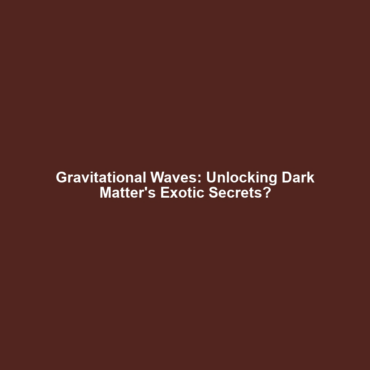Can Gravitational Waves Help Detect Exotic Particles or Phenomena Related to Dark Matter?
Introduction
Gravitational waves, ripples in spacetime caused by colossal astronomical events, hold remarkable potential beyond their initial detection of mergers between black holes and neutron stars. One of the intriguing questions in modern astrophysics is whether gravitational waves can help detect exotic particles or phenomena related to dark matter. Dark matter is believed to make up about 27% of the universe, yet its composition remains a mystery. Understanding how gravitational waves can be utilized to uncover the secrets of dark matter is crucial for advancing our knowledge of the cosmos and could lead to groundbreaking discoveries.
Key Concepts
Understanding Gravitational Waves
Gravitational waves are disturbances in the curvature of spacetime generated by accelerating masses, as described by Einstein’s General Theory of Relativity. Their detection is accomplished through sophisticated instruments like LIGO and Virgo, which measure infinitesimal changes in distance caused by passing waves.
Dark Matter and Its Mystique
Dark matter is referred to as such because it does not emit, absorb, or reflect light, making it invisible and detectable only through its gravitational effects on visible matter. Exotic particles postulated as dark matter candidates include Weakly Interacting Massive Particles (WIMPs) and axions.
Linking Gravitational Waves with Dark Matter
Recent research indicates that gravitational waves could provide indirect evidence of dark matter through their interactions with exotic particles. This connection between gravitational waves and dark matter phenomena is a burgeoning field of study in astrophysics.
Applications and Real-World Uses
The investigative powers of gravitational waves are opening new avenues in the quest to understand dark matter. Here are some applications:
- Detecting anomalies in gravitational wave signals that may imply the presence of exotic particles.
- Studying the gravitational effects of black holes and neutron stars, which can provide insights into dark matter density.
- Utilizing data from gravitational wave observatories to refine theories related to dark matter interactions.
Current Challenges
Despite the promising synergy between gravitational waves and dark matter studies, several challenges persist:
- Noise and Sensitivity: Distinguishing gravitational wave signals from background noise remains a significant hurdle.
- Modeling Complex Interactions: Theoretical models of dark matter are still developing, complicating the interpretation of data.
- Technological Limitations: The current generation of gravitational wave detectors may not have the sensitivity needed to identify faint signals from dark matter interactions.
Future Research and Innovations
Future advancements in gravitational wave astronomy may enhance our ability to detect exotic particles related to dark matter. Key areas of focus include:
- Development of next-gen detectors with improved sensitivity and dynamic range.
- Cross-disciplinary research integrating particle physics and astrophysics to consolidate theories regarding dark matter.
- Exploration of gravitational waves in the context of new physical theories, such as string theory.
Conclusion
The potential of gravitational waves to aid in the detection of exotic particles and phenomena related to dark matter presents an exciting frontier in astrophysics. As research continues to progress, the implications for our understanding of the universe could be profound. For more in-depth information on gravitational waves and dark matter, please visit our related articles on dark matter research and gravitational wave astronomy.








